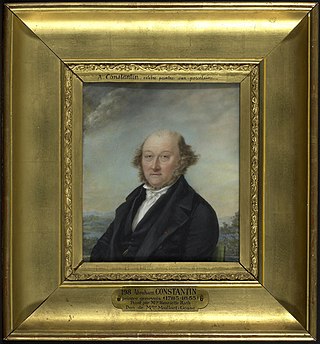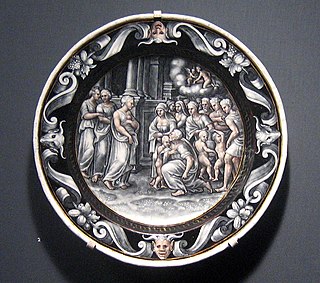
Jean Louis Petitot, French enamel painter, was the eldest son of Jean Petitot, and was instructed in enameling by his father. Some of his works so closely resemble those of the elder Petitot that it is difficult to distinguish between them, and he was really the only serious rival his father ever had. He settled for a while in London, where he stayed until 1682, and painted many enamel portraits of Charles II. In 1682 he removed to Paris, but in 1695 was back again in London, where he remained until his death.

Henry Bone was an English enamel painter. By c. 1800 he had attracted royal patronage for his portrait miniatures This patronage continued throughout the reigns of three monarchs; George III, George IV and William IV. In his early career he worked as a porcelain and jewellery painter. He was elected a Royal Academician and produced the largest enamel paintings ever seen up to that time.

Jean-Baptiste-Joseph Duchesne was a French painter and miniaturist.

Michael Bryan was an English art historian, art dealer and connoisseur. He was involved in the purchase and resale of the great French Orleans Collection of art, selling it on to a British syndicate, and owned a fashionable art gallery in Savile Row, London. His book, Biographical and Critical Dictionary of Painters and Engravers, first published in 1813–1816, was a standard reference work throughout the 19th century, and was last republished in 1920; however it is now badly outdated.
Antidotus was an ancient Greek painter, mentioned by Pliny the Elder in his Natural History
Johann Samuel Arnhold was a German painter.

Henry Pierce Bone was an English enamel painter.

Robert Trewick Bone was an English painter of sacred, classical and genre scenes. He was also an enamel painter.
James M. Burnet was a Scottish painter of rural scenes, based in the London area for most of his career.

John Cawse was a British painter and caricaturist.

Louis de Chastillon (c.1639–1734) was a French painter in enamel and miniature, and an engraver.

Richard Collins (1755–1831) was a British miniature painter.

Abraham Constantin, a Swiss enamel painter, was born at Geneva. He became a pupil of Gérard, after whom he executed many works in enamel and on porcelain, among which may be mentioned, 'Belisarius,' 'Cupid and Psyche,' 'The Entry of Henry IV. into Paris,' and portraits of the King of Rome, Charles X, and the Emperor of Russia. He was attached to the manufactory at Sèvres, and died at Geneva.

Richard Corbould was an English artist, sometimes misspelt "Corbold".
Samuel Cotes (1734–1818) was a younger brother of Francis Cotes, R.A. He was a successful painter of miniature portraits and also worked in crayons. He died in Chelsea in 1818.
Jean Court, called Vigier, was one of the most skillful of the Limoges enamel painters who flourished at Limoges in the 16th century. His works are very rare and bear the dates 1556 and 1557 only. Almost all are painted in grisaille on a black ground, and heightened with gold, the flesh being tinted. Some of his enamels are in the Louvre. He died about 1583, being then not less than 72 years of age. Much confusion has existed on account of the similarity of the names and monograms, and often of the works, between this artist, Jean de Court, and Jean Courteys.
Jean de Court used painted Limoges enamel and oil painting, and served as official portrait painter to the monarchs of Scotland and France. The de Court dynasty of enamel painters ran a workshop making Limoges enamel over several generations in Limoges in south-western France.

Pierre Courteys was a French enamel painter, working in Limoges.
Willem de Keyser or De Keysar was a Flemish artist.

Jacques-Philippe Ferrand (1653–1732) was a French miniaturist and painter in enamel.













